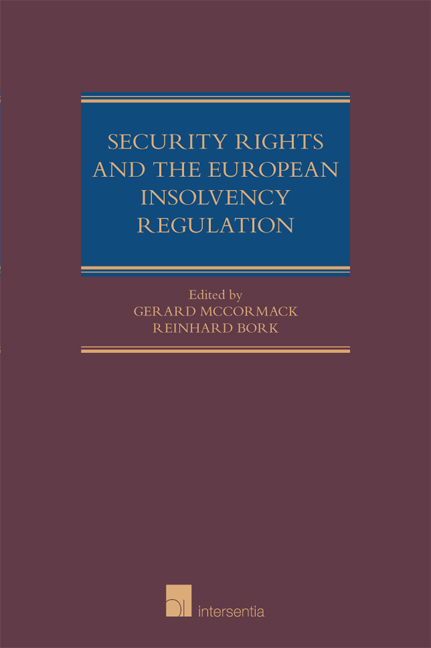Book contents
- Frontmatter
- Disclaimer
- Preface
- Contents
- Questionnaire
- Table of Cases
- Table of Abbreviations
- Part I Comparative Analysis
- Introduction
- Chapter 1 Security Rights under Article 5 of the Insolvency Regulation and Article 8 of theRecast
- Chapter 2 Transactional Avoidance and the Insolvency Regulation
- Chapter 3 Security Rights, National Laws and Possible Reforms
- Chapter 4 Transactional Avoidance, National Laws and Possible Reforms
- Part II National Reports
- Index
- List of Authors
Chapter 4 - Transactional Avoidance, National Laws and Possible Reforms
from Part I - Comparative Analysis
Published online by Cambridge University Press: 21 September 2018
- Frontmatter
- Disclaimer
- Preface
- Contents
- Questionnaire
- Table of Cases
- Table of Abbreviations
- Part I Comparative Analysis
- Introduction
- Chapter 1 Security Rights under Article 5 of the Insolvency Regulation and Article 8 of theRecast
- Chapter 2 Transactional Avoidance and the Insolvency Regulation
- Chapter 3 Security Rights, National Laws and Possible Reforms
- Chapter 4 Transactional Avoidance, National Laws and Possible Reforms
- Part II National Reports
- Index
- List of Authors
Summary
INTRODUCTION
In Chapter 2 it was explained that in cases with a cross-border EU element, Article 13 of the EIR (Article 16 of Recast) makes it difficult for an insolvency practitioner (IP) successfully to challenge transactions that have been entered into by the debtor prior to the commencement of formal insolvency proceedings and that are detrimental to the general body of creditors. The defendant in any avoidance action has a defence if it can show that the transaction was subject to the law of an EU Member State which does not allow avoidance in the particular case. Inevitably the IP‘s task is more difficult and it becomes a struggle to capture or recapture‘ value’ for the benefit of the insolvency estate. The effect of the Article 13 defence is greatly to narrow the potential application of avoidance provisions and therefore greatly to weaken implementation of the policies of fairness and priority that underlie such avoidance provisions. To take an example, the law of the forum State may have 7 avoidance preconditions in its insolvency law but only 2 of these are shared with the State to whose laws the transaction is subject. This State however, may have 5 additional requirements. Therefore, to challenge the transaction successfully the IP would need to overcome an effective double avoidance hurdle and establish that all 12 elements were present in the particular case once the defendant raised the lex causae as a defence. This is a tough burden for the IP on any reckoning.
The Article 13 defence is designed to safeguard the stability of transactions and to protect legitimate transactions. Chapter 2 discussed Article 13 in detail and explored various options for achieving a more appropriate balance in reconciling and accommodating the potentially conflicting goals of transactional avoidance and transactional stability. One of these options was to harmonise the substantive law on transactional avoidance in the EU Member States but this may not be a realistic and feasible option given the divergences between current national laws. The main part of this chapter considers in detail and from a comparative perspective, the substantive law on transactional avoidance in the countries that form the subject matter of this research project.
- Type
- Chapter
- Information
- Security Rights and the European Insolvency Regulation , pp. 121 - 170Publisher: IntersentiaPrint publication year: 2017

